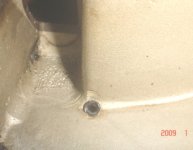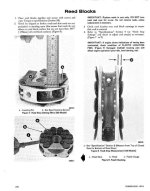centerline
Regular Contributor
I need some Ideas from mechanics who have lots of "top end" experience with these older motors.
I have an 85hp merc that starts and SEEMS to run fine on the muffs, but will not accelerate when its on the lake... it does run rich at times and floods easily during start up, but the carbs have been went thru without any change in performance..
I have had it into the merc repair shop and he double checked the carbs then did a compression test. all 4 cylinders read about 140psi (all within 3lbs of one another). the spark plugs looked fine and all even, but it seemed like the motor was still running a bit rich, so the tech changed the plugs and re-checked the tune of the carbs and the timing, and claims it should run great now.... but it doesnt.
after three trips into the shop, the mechanic thought it might just be me expecting too much from the motor, so he went with me to the lake to see what I was complaining about... and he finally agreed that there is something seriously wrong, but he has absolutely no idea what to look for next, other than tear it down and do a rebuild of the motor.
while we were on the water, he pulled the plugs to look for water, and the plugs showed no side of water in any of the cylinders.
he said the motor has some top end noise, but again, has no idea what it could be, as the compression is good (we rechecked it to make sure the first readings were correct, and he also looked into the cylinders with a bore scope, and it checks out good....
on the muffs it accelerates quickly and seems to run normal, although sometimes it seems to want to flood when starting, but most times it starts and idles immediately....
on the water, it will increase rpms VERY slowly only if you move the accelerator slow... if you move the lever too fast, the engine will start to load up and you have to back out of it to keep it running... any quick "hole shot" acceleration will flood the engine and kill it.
even though its a 1975 motor, it looks nearly new. it's very clean and the original paint is still shiny, and without any corrosion whatsoever.
the only history I have about it is that the motor sat for several years without running, and then when it was sold, the new owner (who I got it from) could never get it to run right... after tinkering with it himself he got tired of it and just replaced it with a new 4stroke motor.
I am not familier with the reed valves in an outboard, but I am wondering if they could be stuck or broken causing this, and if so, why couldnt the merc tech suspect this....
any suggestions as to what else could cause this issue or where I should look....
I have some advanced mechanical skills, and even though I have had a few merc engines before, I an not an outboard mechanic.... the mercs I have owned in the past always started quickly and had no problems. so i dont really know what to look for here.
Thanks for any help or suggestions
I have an 85hp merc that starts and SEEMS to run fine on the muffs, but will not accelerate when its on the lake... it does run rich at times and floods easily during start up, but the carbs have been went thru without any change in performance..
I have had it into the merc repair shop and he double checked the carbs then did a compression test. all 4 cylinders read about 140psi (all within 3lbs of one another). the spark plugs looked fine and all even, but it seemed like the motor was still running a bit rich, so the tech changed the plugs and re-checked the tune of the carbs and the timing, and claims it should run great now.... but it doesnt.
after three trips into the shop, the mechanic thought it might just be me expecting too much from the motor, so he went with me to the lake to see what I was complaining about... and he finally agreed that there is something seriously wrong, but he has absolutely no idea what to look for next, other than tear it down and do a rebuild of the motor.
while we were on the water, he pulled the plugs to look for water, and the plugs showed no side of water in any of the cylinders.
he said the motor has some top end noise, but again, has no idea what it could be, as the compression is good (we rechecked it to make sure the first readings were correct, and he also looked into the cylinders with a bore scope, and it checks out good....
on the muffs it accelerates quickly and seems to run normal, although sometimes it seems to want to flood when starting, but most times it starts and idles immediately....
on the water, it will increase rpms VERY slowly only if you move the accelerator slow... if you move the lever too fast, the engine will start to load up and you have to back out of it to keep it running... any quick "hole shot" acceleration will flood the engine and kill it.
even though its a 1975 motor, it looks nearly new. it's very clean and the original paint is still shiny, and without any corrosion whatsoever.
the only history I have about it is that the motor sat for several years without running, and then when it was sold, the new owner (who I got it from) could never get it to run right... after tinkering with it himself he got tired of it and just replaced it with a new 4stroke motor.
I am not familier with the reed valves in an outboard, but I am wondering if they could be stuck or broken causing this, and if so, why couldnt the merc tech suspect this....
any suggestions as to what else could cause this issue or where I should look....
I have some advanced mechanical skills, and even though I have had a few merc engines before, I an not an outboard mechanic.... the mercs I have owned in the past always started quickly and had no problems. so i dont really know what to look for here.
Thanks for any help or suggestions



